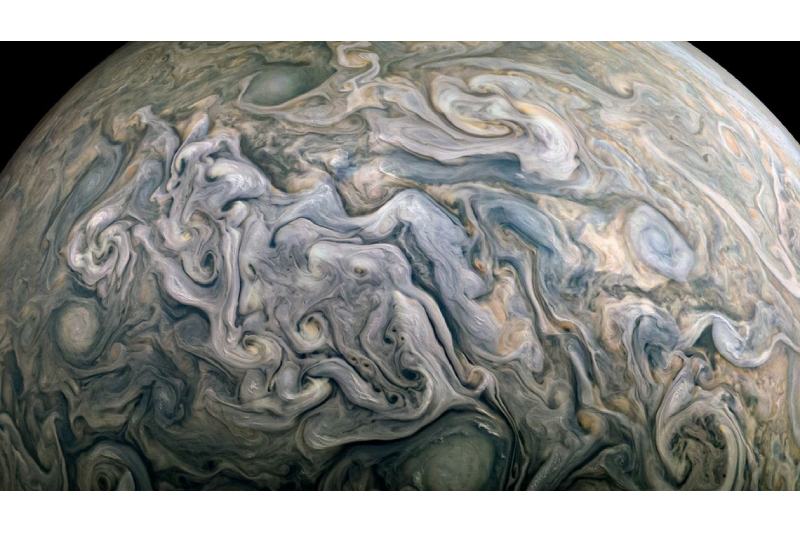On May 12, 2024, on its 61st close flyby, Juno took a breathtaking color-enhanced picture of Jupiter’s northern hemisphere that revealed the planet’s erratic and dynamic cloud patterns.
For scientists researching planetary atmospheres, this image provides a thorough glimpse of the complex atmospheric conditions that define Jupiter.
Investigating the Northern Hemisphere of Jupiter
The folded filamentary region was photographed by Juno on his most recent visit. This area is known for its cyclonic storms and turbulent cloud patterns, which change quickly over a few days. In these regions, the zonal jets that normally produce Jupiter’s well-known banded patterns disintegrate, resulting in the chaotic cloud forms that are seen.
Gary Eason, a citizen scientist, altered the JunoCam instrument’s raw data to improve the image’s clarity and color. At a latitude of roughly 68 degrees north of the equator, Juno was at a distance of about 18,000 miles (29,000 kilometers) above Jupiter’s cloud tops when the picture was taken. The planet’s atmospheric processes are clearly and in-depthly seen from this high-altitude viewpoint.
Citizen Science’s Role
Gary Eason and other citizen scientists are crucial in NASA’s missions by analyzing raw photographs from spacecraft such as Juno. Jupiter’s cloud patterns were captured with brilliant hues and minute details by Eason using digital processing techniques. This public-NASA collaboration not only makes the photos more visually appealing, but it also highlights aspects that may otherwise go overlooked, which helps with scientific study.
The raw photos from JunoCam are openly accessible for processing by anyone. NASA invites enthusiasts to visit the JunoCam Processing webpage and contribute to this project. This program increases public participation in space exploration and advances knowledge of Jupiter among scientists in general.
Observations from Juno: New Information
The observations made by Juno offer important new information about Jupiter’s atmospheric processes. Scientists are particularly interested in the folded filamentary zones. These regions show how many atmospheric forces interact to produce the unique cloud forms and weather patterns found across the world. Researchers intend to learn more about the mechanisms governing Jupiter’s atmospheric dynamics by examining these locations.
The information gathered by Juno advances our knowledge of planetary atmospheres, including Earth’s. Scientists can improve their models of atmospheric dynamics and forecasts of weather and climate systems by comparing Jupiter’s atmospheric phenomena with those seen on other planets. Understanding the basic mechanisms that mold planetary habitats throughout the solar system depends on this knowledge.
The Broader Impact of Juno’s Mission
The main goal of Juno, which was launched in 2011, is to use long-term, up-close studies to better understand Jupiter’s formation, structure, atmosphere, and magnetosphere. Ever since entering Jupiter’s orbit in 2016, Juno has offered previously unheard-of insights into the mechanics of the planet. Thanks to the spacecraft’s array of scientific sensors, scientists have been able to see through cloud cover and examine Jupiter’s atmospheric conditions and magnetic field in more detail.
Scientists find the folded filamentary regions observed on this flyby particularly fascinating. These regions demonstrate how various atmospheric forces interact to produce the unique cloud forms and weather patterns found around the world. Researchers intend to learn more about the mechanics underlying Jupiter’s atmospheric behavior by examining these regions.
The consequences of Juno’s findings go beyond Jupiter. Scientists can better comprehend Earth’s atmosphere by using Juno’s observations of the largest planet in our solar system, which also helps them understand the dynamics of other planets’ atmospheres. This comparison method advances our understanding of planetary science and aids in the creation of more precise models to forecast changes in the planet’s temperature and weather.
